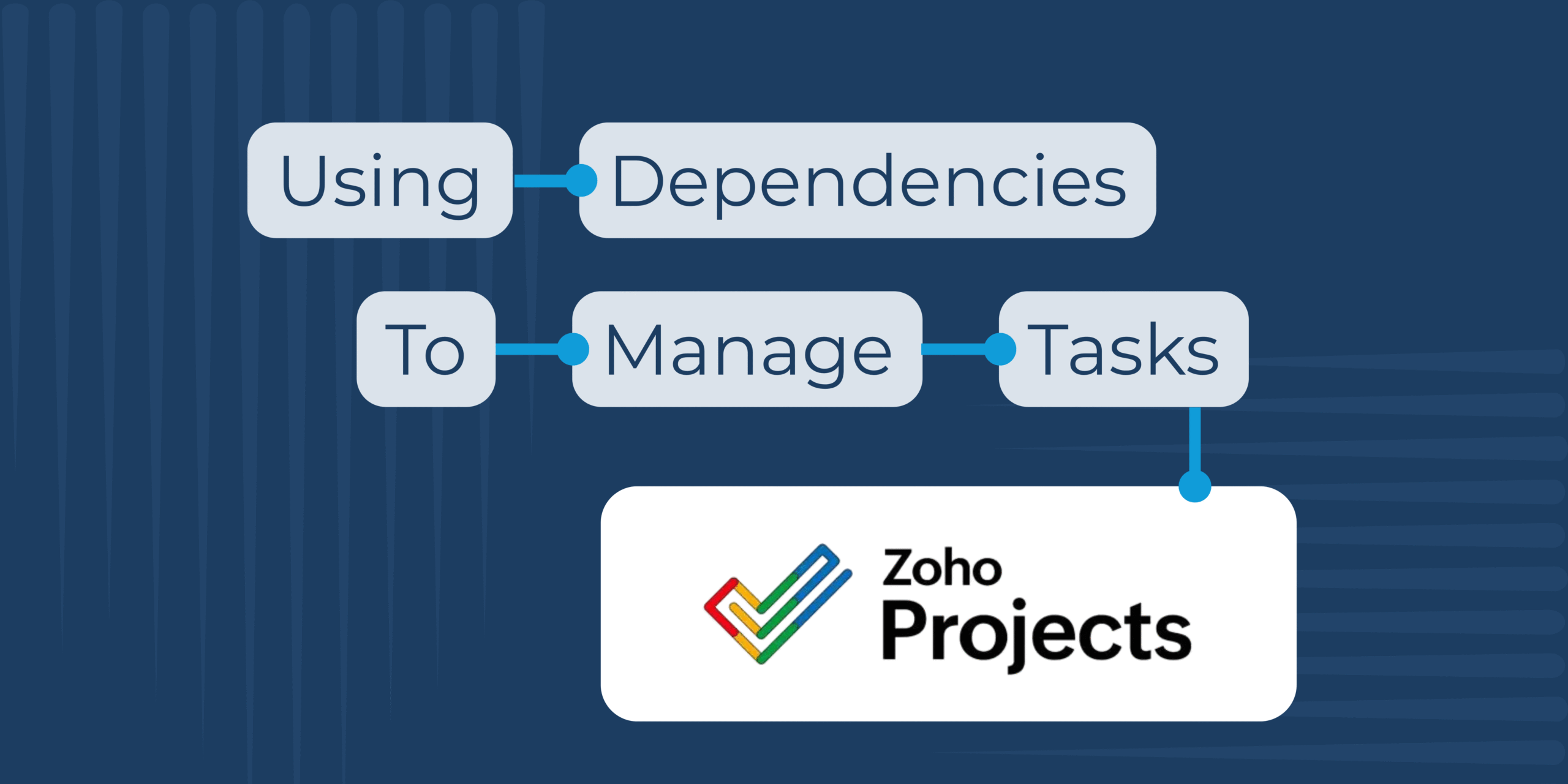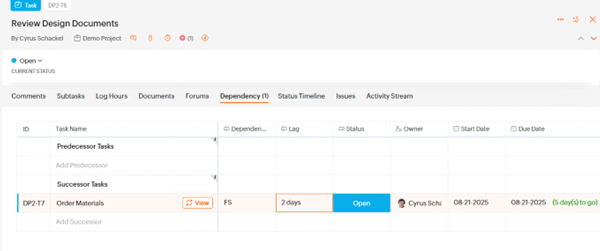Often, when working with Project Management software, the tasks that your team needs to complete are all interrelated. Some tasks are sequential, while others may need to happen concurrently but can have a profound impact on each other. Your process may also be such that pushing forward or backward one task may require adjusting the timing of other related tasks. Trying to manage all these task relationships can be difficult for Project managers to keep track of.
Thankfully, Zoho Projects provides the “Dependency” feature to assist Project Managers with these exact issues.
Uses of Dependencies
Dependencies allow Project Managers to establish predecessor/successor relationships between different tasks. These relationships can help each User by determining if their Task is awaiting the start or completion of another task.
Dependencies can also allow Users to affect the dates/timing of all related tasks when adjusting a predecessor task. Related sections of the project can be adjusted without the need to move each individual task.
Understanding Dependency Types
Zoho Projects provides 4 types of Dependency, which are each useful in different circumstances:
-
- Finish-to-Start (FS): This type of Dependency is used when the predecessor task needs to be Finished, before the successor task can be Started. In most cases, this is the ideal dependency when you have a set of sequential tasks, since tasks later in the sequence cannot be started unless the tasks earlier in the sequence are completed.
- Start-to-Start (SS): This type of Dependency is used when the predecessor task needs to be Started, before the successor task can be Started. This type of dependency can be used when a task may rely on another task/process to be underway for the task to begin, but does not necessarily rely on the first task to be completed.
- Start-to-Finish(SF): This type of Dependency is used when the predecessor task needs to be Started, before the successor task can be Finished. This type of dependency can be used when the successor task may begin before the predecessor task but should not be completed until the predecessor task has begun.
- Finish-to-Finish (FF): This type of Dependency is used when the predecessor task needs to be Finished, before the successor task can be Finished. This is ideal for tasks that can be worked on simultaneously, but the successor task requires another task to be fully completed before it can be closed.
From my experience, the “Finish-to-Start” task is the most commonly used type of dependency, since this allows for the proper coordination of sequential tasks and provides an easy-to-understand flow of events
For more information on the different Dependency Types and their uses, the Zoho Projects documentation provides an excellent overview of the different dependency types.
Working with Lag:
Lag allows Users to define a certain number of days/hours between dependent tasks. As an example, if a “Review Design Documents” task has a “Finish-to-Start” dependency with an “Order Materials” task, a lag time of ‘2 days’ would indicate that the “Order Materials” task would begin 2 days after the end of the “Review Design Documents” task.
This feature is useful for controlling the timing between various dependent tasks that need specific amounts of time between them.
Adding Dependencies to Tasks
Dependencies can be added to tasks in multiple ways in Zoho Projects:
Adding Dependencies via the Task Form:
To add dependencies to a Task, open the ‘Detail View’ of the Task, and open the ‘Dependency sub-grid:
From this sub-grid, you can click into the “Add Predecessor” or “Add Successor” grid and identify the name/id of the related task, select the Dependency type, and identify any needed lag/lead time between the related tasks.
Adding Dependencies via the Gantt View:
In the Gantt View, dependencies are visualized as a black line between 2 tasks. New dependencies can be added by hovering your mouse over the task until a black dot appears on either side of the task, and then clicking and dragging to the dot on the linked task:
Please note that which dot (leading or trailing) you draw this line from on each task will determine what kind of Dependency Type is added. For example, if you start this line from the trailing dot on the predecessor task to the leading dot on the successor task, this will create a Finish-to-Start dependency. Similarly, connecting the leading dot to the leading dot will create a Start-to-Start dependency.
General Recommendations
Since dependencies can provide benefits to the flow of the project and to the timing of events, we generally recommend that dependencies be added to any related tasks in the Project. When dependencies are chained together, adjusting the dates/timing of just a few tasks help to better identify issues that may arise.
We also recommend that dependencies be added to Project Templates if certain dependencies are always relevant, since this will save time for each of the individual Project Managers that may need to normally add in dependencies for each project they manage.
Project Management can help many organizations better manage their processes and increase their efficiency and transparency. If you think this tool could benefit you and your business, please reach out to us at info@toplineresults.com.




You must be logged in to post a comment.